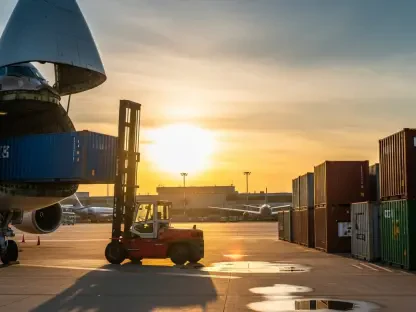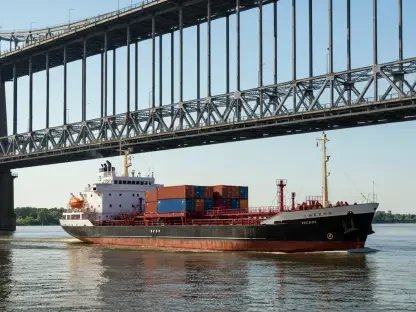What does it take to transform a global logistics titan in an era where same-day delivery is no longer a luxury but a baseline expectation? FedEx is tackling this challenge head-on with its ambitious Network 2.0 initiative, a sweeping plan to integrate operations and redefine efficiency. Having already reached a 25% completion milestone, this effort signals a pivotal shift for the company and the broader delivery industry. This journey promises not just cost savings but a reimagined customer experience, setting the stage for a deeper look into how FedEx is navigating one of the most significant transformations in its history.
Why This Milestone Signals a Logistics Revolution
At the heart of FedEx’s transformation lies a critical need to adapt to the relentless pace of e-commerce and rising customer expectations. The 25% completion of Network 2.0 isn’t merely a progress update; it’s a testament to a strategic pivot aimed at merging the once-separate Ground and Express operations. This integration seeks to eliminate inefficiencies and position FedEx as a more agile competitor in a crowded market.
The importance of this initiative cannot be overstated. With online shopping continuing to dominate retail trends, logistics companies face immense pressure to deliver faster and cheaper. Network 2.0 represents FedEx’s answer to this demand, promising not only operational streamlining but also enhanced service reliability. As competitors like UPS already offer seamless integrated services, this overhaul is less a choice and more a necessity for FedEx to maintain its edge.
This milestone also carries weight for stakeholders beyond the company’s walls. Businesses relying on FedEx for supply chain solutions and consumers expecting timely deliveries stand to gain from a network that prioritizes both cost-effectiveness and quality. The 25% mark serves as an early indicator of potential success, hinting at the transformative impact awaiting full implementation.
Unveiling the Vision Behind Network 2.0
Network 2.0 is built on a foundation of bold innovation, targeting the consolidation of operations that have historically functioned in silos. By unifying Ground and Express services, FedEx aims to reduce redundancies that have long plagued its cost structure. This isn’t just about cutting expenses—it’s about creating a leaner, more responsive system capable of meeting modern logistics challenges.
The initiative’s scope extends beyond internal restructuring. A key goal is to enhance the customer experience by simplifying processes, such as enabling single-appointment pickups for both standard and expedited shipments. This mirrors offerings already available from rivals, underscoring FedEx’s intent to close competitive gaps while addressing market demands for convenience and speed.
Financially, the stakes are high. Projections estimate savings of $1 billion by fiscal year 2026, driven by transformation efficiencies and the Network 2.0 rollout. This financial incentive, coupled with the strategic need to stay relevant in an e-commerce-driven world, positions the initiative as a cornerstone of FedEx’s long-term growth strategy.
Tracking the Numbers: Progress and Targets
Delving into the specifics, FedEx has made measurable strides with Network 2.0, currently standing at 25% completion. The plan is to reach 40% by the end of the fiscal year on May 31, with full implementation across the U.S. targeted for 2027. Starting with a successful rollout in Canada, the initiative has now expanded to the U.S., demonstrating a phased approach to scaling this massive undertaking.
Operationally, the transformation is already taking shape. Around 360 facilities have been converted to handle both Express and Ground volumes, processing 18% of the average daily volume in the U.S. through integrated hubs as of the first quarter. Additionally, 140 facilities have been closed to eliminate overlap, a move designed to optimize the network by reducing duplicative efforts and focusing resources where they matter most.
These metrics highlight a deliberate balance between progress and pragmatism. While the numbers reflect steady advancement, they also underscore the complexity of reconfiguring a sprawling logistics network. Each converted facility and closed station represents a step toward a more unified operation, with the promise of greater efficiency on the horizon.
Leadership Insights and Industry Reactions
Confidence in Network 2.0 resonates from the top levels of FedEx’s leadership. President and CEO Raj Subramaniam has emphasized the initiative’s early successes, particularly citing strong service levels in the fully completed Canadian rollout. During a recent earnings call, Subramaniam projected a similarly positive trajectory for the U.S., framing the current progress as a foundation for broader achievements.
Industry analysts share this optimism, with experts noting the mature profit margins achieved in Canada as a promising sign for the U.S. market. However, there’s an acknowledgment of hurdles, such as temporary cost redundancies in transitioning terminals. These short-term expenses are seen as necessary to maintain service quality during the overhaul, reflecting a cautious yet determined approach.
This blend of enthusiasm and realism paints a nuanced picture. While the path forward appears bright, the challenges of managing costs alongside operational shifts are not overlooked. The consensus points to Network 2.0 as a high-stakes endeavor with the potential to redefine FedEx’s standing if executed with precision.
What It Means for Businesses and Customers
For businesses partnered with FedEx, Network 2.0 offers valuable lessons in strategic adaptation. The phased rollout—starting small in Canada before expanding to the U.S.—demonstrates the importance of testing and refining large-scale changes. Companies can apply this model to their own operations, prioritizing data-driven adjustments over rushed transformations.
Customers, on the other hand, can look forward to tangible benefits as the initiative progresses. The ability to schedule pickups for both standard and expedited services in one go is a practical improvement, aligning FedEx’s offerings with industry standards. This change aims to simplify logistics for end-users, potentially reducing delays and enhancing reliability.
Staying informed about the rollout timeline, particularly the 2027 U.S. target, is crucial for stakeholders. Businesses can plan their logistics strategies around expected cost savings and service upgrades, while customers can anticipate a more streamlined delivery experience. Network 2.0 isn’t just a corporate project—it’s a shift that could ripple through supply chains and consumer interactions alike.
Reflecting on a Transformative Journey
Looking back, FedEx’s push to reach the 25% completion mark in Network 2.0 stood as a defining moment in its quest for reinvention. The integration of Ground and Express operations, coupled with significant facility consolidations, marked a clear commitment to efficiency and customer satisfaction. Each step taken during this phase laid critical groundwork for the challenges and opportunities that followed.
As the journey unfolded, the focus shifted toward actionable next steps. Businesses were encouraged to monitor FedEx’s progress closely, leveraging upcoming efficiencies to optimize their own logistics frameworks. For consumers, the evolving network hinted at a future of smoother, more reliable deliveries, a prospect worth anticipating.
Beyond immediate impacts, the broader implication of this overhaul lingered as a point of reflection. The balance between managing transition costs and maintaining service quality emerged as a key lesson for any industry undergoing transformation. FedEx’s experience served as a blueprint, urging others to embrace change with both boldness and careful planning as they navigated their own paths forward.









